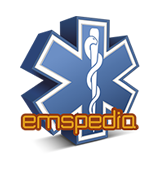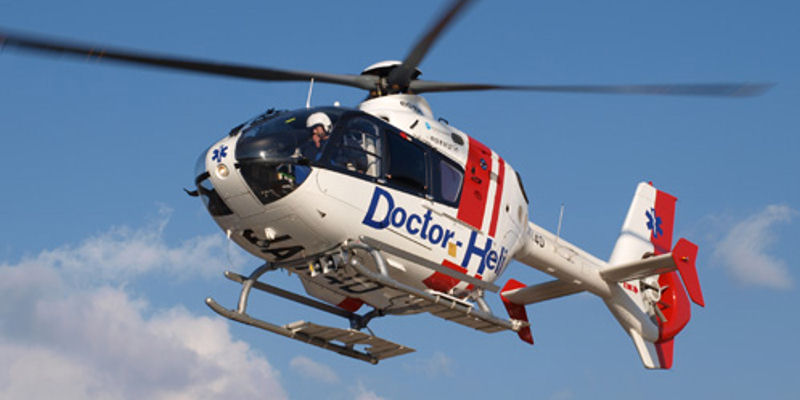Between 2001 and 2013 the physician staffed medical helicopter (Doctor-Heli) system in Japan grew tremendously, from the original four programs to forty-two. Prior to the deployment of a Doctor-Heli aircraft, many prefectures utilized a municipal rescue helicopter to respond to medical emergencies requiring air transport. The level of care that these aircraft are equipped to provide is far less than that which their physician staffed equivalents provide. As a result, prehosptial care systems needed to adapt significantly to integrate the new resource.
The prefecture of Miyazaki, located at the southern portion of the island Kyushu, began operating a Doctor-Heli program out of the University of Miyazaki Hospital in 2012. Miyazaki is a relatively rural area of Japan. Its total population is about one million people, 420,000 of which live in the capital city of Miyazaki. Agriculture is a large portion of the economy. Its geography is broad, ranging from river delta to mountainous terrain. Prior to the arrival of the physician-staffed helicopter, Miyazaki had a municipal rescue helicopter that served a broad mission profile that included hoist operations, basic medical care, and fire suppression. Miyazaki uses a fire-based ground EMS system, much like many of the prefectures of Japan. University of Miyazaki Hospital is a large tertiary care hospital with recent expansion of its Acute Care and Traumatology Department.
Introduction of the aircraft into the local system required several different components and involved many stake holders. The hospital built an on site heliport and both fire fighters and civil servants throughout the prefecture were trained on the designated landing zones within their locale. More then 200 designated landing zones were identified, prefecture-wide. A few of the hospital physicians underwent extensive training, flying with already established Doctor-Heli programs. These then introduced a local training program with graduated responsibility to the other physicians.
The University of Miyazaki also reached out to its United States sister institution, the University of California, Irvine to collaborate in the areas of EMS system integration and maturation. This collaboration resulted in a regional utilization manual for the aircraft. The manual is intended for ground paramedics and physicians in community hospitals. It aimed to establish appropriate standards for the utilizations of this new resource. It included several general indications for the request of the aircraft as well as those that are symptom based. These guidelines were developed to reflect the current scope of practice of paramedics in Japan and the absence of designated specialty centers within the Miyazaki’s EMS system. The manual has three major goals. The first is providing clear indications to paramedics in the field when this new resource should be requested. Second, is to facilitate the collection of better utilization data, allowing system maturation to be an ongoing process. Third, is to lay the groundwork for the establishment of a prehospital care data collection system for the entire prefecture, involving ground, aviation, and receiving centers.
In the first ten months of operation the aircraft flew over 300 missions and its mission volume has increased since. Doctor-Heli in Miyazaki prefecture provides a successful model for how a region can safely and successfully integrate a new air ambulance into their EMS system.
Robert Katzer MD MBA
University of California, Irvine
Center for Disaster Medical Sciences
ROBERT JAMES KATZERAssociate Clinical Professor, Emergency Medicine Associate Director, EMS Medical Director, ED Observation Unit Associate Director, Base Hospital Director, Resident EMS Rotation, Emergency Medicine Director, Emergency Department Nurse Practitioners, Emergency Medicine Faculty Advisor, Wilderness Medicine Interest Group B.A., University of California, Berkeley, 2004, Molecular and Cell Biology M.D., Temple University, School of Medicine, 2008 M.B.A., University of California, Irvine, 2013 Phone: (714) 456-5239 University of California, Irvine |
 |
|
|
||
| Research Interests |
Emergency Medical Services, Medical Education | |
| Academic Distinctions |
Dean’s Scholar, University of California, Irvine 2013 Beta Gamma Sigma Honor Society 2013 Alpha Omega Alpha Honor Medical Society 2008 Fellow, American College of Emergency Physicians Fellow, National Association of EMS Physicians |
|
| Publications | The WILDMED Race: A new look at a developing simulation-based Wilderness Medicine Learning Experience Tom Murphy MD, Victor Jourdain MD, Robert Katzer MD Accepted for publication, Journal of Special Operations Medicine |
|
| The Use of a Physician in Triage Model in the Management of Abdominal Pain in an Emergency Department Observation Unit John R. Marshall MD, Robert Katzer MD, Shahram Lotfipour MD, Bharath Chakravarthy MD, Siri Shastri MD, Jessica Andrusaitis, Erik Barton MD. Western Journal of Emergency Medicine. 2017 Feb18(2):181-188 |
||
| Weather Webcam System for the Safety of Helicopter Emergency Medical Services in Miyazaki, Japan Katsuhiro Kanemaru MD, Robert Katzer MD, Syo Hanato, Koji Nakamura, Hiroshi Matsuoka MD, Hidenobu Ochiai MD PhD Air Medical Journal 36 (2017) 71-76. |
||
| Management of In-flight Emergencies: Are Senior Medical Students Prepared to Respond to this Community Need? Robert Katzer MD MBA, Matthew Weber MD MPH, David Duong MD MS, Amy Memmer BA, Ian Buchanan BA Western Journal of Emergency Medicine Accepted for publication September, 2014 |
||
| The University of California, Irvine, Center for Disaster Medical Sciences Partnership with Miyazaki, Japan’s Emerging Doctor-Heli Program. Robert Katzer MD, Pamela Swan MD, Kristi L. Koenig MD. ACEP EMS and Aeromedical Section Newsletters May, 2013 |
||
| In-flight Medical Emergencies: Creation of a Novel Simulation Based Medical Student Curriculum. Robert Katzer MD, Erica Frumin MD, Danielle Silverman MD, Kristi L. Koenig MD, Carl H. Schultz MD Medical Teacher Early Online April, 2013 |
||
| Impact of Implementing an EMR on Physical Exam Documentation by Ambulance Personnel. Robert Katzer MD, David J. Barton EMT-B, Sam Adelman EMT-B, Sophie Clark EMT-B, Elizabeth Seaman EMT-B, Korin B Hudson MD EMT-P Applied Clinical Informatics 2012; 3: 301-308 |
||
| Emergency Medical Services Education in Emergency Medicine: A National Survey. Robert Katzer MD, Jose Cabanas MD, Christian Martin-Gill MD Academic Emergency Medicine 2012; 19: 174-179 |
||
| AAEM Resident and Student Association Toxicology Handbook Second Edition 2012, Subchapter on class III antiarrhythmic agents (Authored) |
||
| Multicenter Validation of the Philadelphia EMS Admission Rule (PEAR) to Predict Hospital Admission in Admission in Adult Patients Using Out-of-hospital Data. Zachary F Meisel, MD, MPH, Rex Mathew, MD, Gerald Wydro, MD, C. Crawford Mechem, MD, MS, Charles V. Pollack, MD, MA, Robert Katzer, MD, Anjeli Prabhu, Adora Ozumba, MD, and Jess M. Pines, MD, MBA, MSCE Academic Emergency Medicine 2009; 16:519-525 |
||
| Other Experience | Emergency Medicine Resident Washington Hospital Center, Georgetown University 2008—2011 |
|
| Emergency Medical Services Fellow University of California, Irvine 2011—2013 |
||
| Medical Officer CA-1 DMAT, National Disaster Medical System |
||
| Flight Physician San Bernardino County Sheriff’s Air Rescue |
||
| Board Certified, Emergency Medicine | ||
| Board Certified, Emergency Medical Services | ||
| Medical Director City of Anaheim, Fire and Rescue 2017 |
||
| Link to this profile | http://www.faculty.uci.edu/profile.cfm?faculty_id=5980 | |


